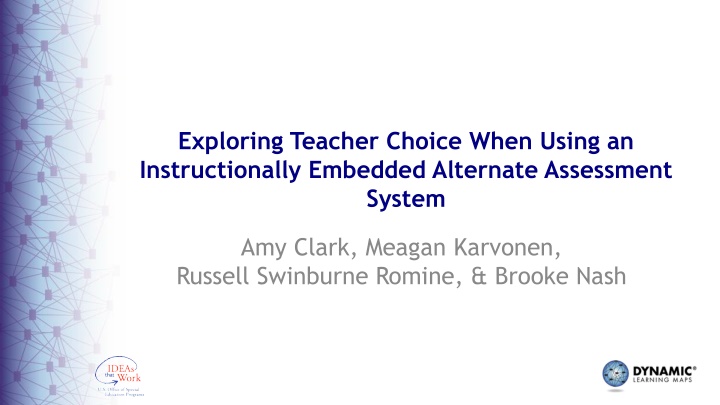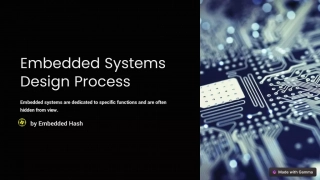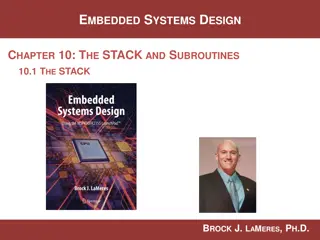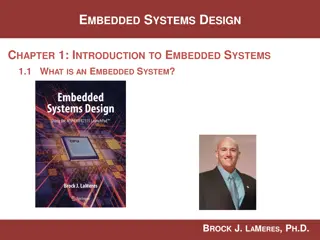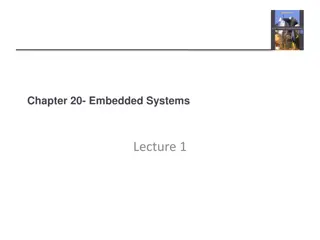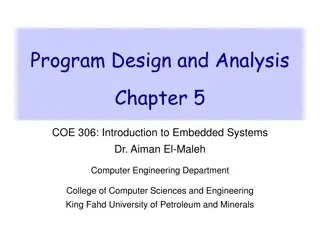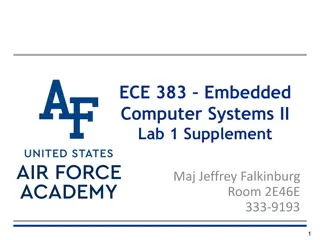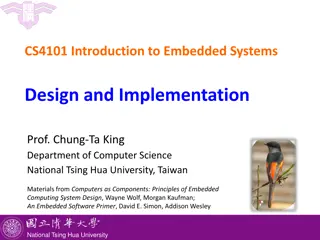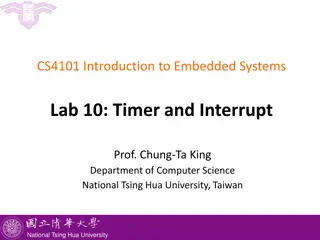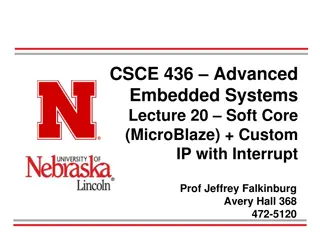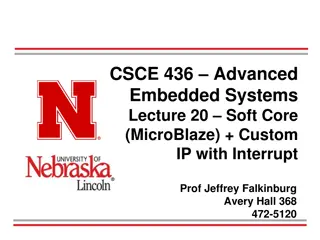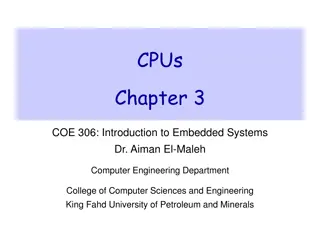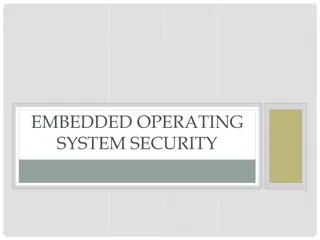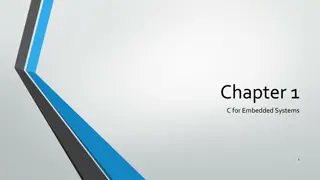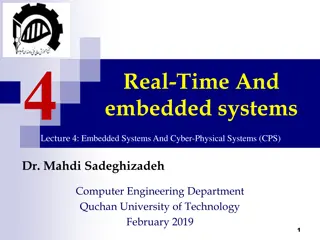Teacher Choice in Instructionally Embedded Assessment Systems
This study explores how teachers can make choices when using an instructionally embedded alternate assessment system for students with significant cognitive disabilities. It discusses implications, assessment overview, background information, creation of instructional plans, assessments at different levels, and issues to consider for such assessments.
Download Presentation

Please find below an Image/Link to download the presentation.
The content on the website is provided AS IS for your information and personal use only. It may not be sold, licensed, or shared on other websites without obtaining consent from the author.If you encounter any issues during the download, it is possible that the publisher has removed the file from their server.
You are allowed to download the files provided on this website for personal or commercial use, subject to the condition that they are used lawfully. All files are the property of their respective owners.
The content on the website is provided AS IS for your information and personal use only. It may not be sold, licensed, or shared on other websites without obtaining consent from the author.
E N D
Presentation Transcript
Exploring Teacher Choice When Using an Instructionally Embedded Alternate Assessment System Amy Clark, Meagan Karvonen, Russell Swinburne Romine, & Brooke Nash
Session Overview Background on the assessment system & population Summary of teacher choice using instructionally embedded assessment during 2016-2017 Implications and next steps 2
Background The DLM consortium administers assessments to students with significant cognitive disabilities Five states participate in the integrated model blueprint, which provides summative results based on testing conducted throughout the year for English language arts and mathematics Assessment designed to occur alongside instruction and inform subsequent instructional decision making 4
Creation of Instructional Plans Teachers create instructional plans using an online system They select the content standard and level at which they want to instruct and assess the student Alternate achievement standards are Essential Elements Assessments are available at five levels, known as linkage levels, for each content standard Initial Precursor Distal Precursor Proximal Precursor Target Successor 5
Blueprint Flexible design is intended to allow teachers to assess students at a frequency and level that best meets their students needs, IEP goals, etc. Standards are organized within Claims and Conceptual Areas of similar content The blueprint specifies content standards available and guidelines for selection for each grade and subject E.g. Choose 3 standards within Conceptual Area 1.1 7
Issues to Consider for Instructionally Embedded Assessments Consider how we define fidelity in context of an assessment that intentionally allows for teacher choice in depth, breadth, and frequency of assessment Examine differences in administration patterns and how they relate to student performance Determine the implications for the validity of inferences made from results when there is intended flexibility in student testing experience 8
Research Questions 1. When are the peak times during which teachers choose to administer more testlets? 2. Do teachers select the linkage level recommended by the system or a different level? 3. Which standards do teachers tend to choose from among those available on the blueprints? 4. To what extent do teachers assess the same student more than once on a standard? 9
Participation 13,334 students with significant cognitive disabilities from 5 states 4,241 teachers created instructional plans and administered testlets Each instructional plan is measured by a 3-8 item testlet Measures a single content standard at a single linkage level selected by the teacher Total of 201,348 testlets were administered during 2016-2017 instructionally embedded testing 10
RQ 1: Peak Testing Patterns The 2016-2017 instructionally embedded window was available from September through February for teachers to administer assessments covering the full blueprint Teachers have choice of when and how frequently to assess their students within that time period 12
Average Number of Testlets Administered to Students per Week Number of Testlets 0 2 4 6 8 10 12 14 16 18 20 1 2 3 4 5 6 7 8 9 10 11 12 13 14 15 16 17 18 19 20 21 22 Week Average number of testlets taken by students who took <= 10 testlets in a week Average number of testlets taken by students who took > 10 testlets in a week 14
RQ 2: System-Recommended Linkage Level Prior to testing, all teachers complete a survey for each student of learner characteristics Responses to items in ELA, math, and expressive communication result in a complexity band for each content area Four total complexity bands: Foundational, Band 1, Band 2, Band 3 15
Correspondence of Complexity Bands to System-Recommended Linkage Level Initial Precursor Foundational Distal Precursor Band 1 Proximal Precursor Band 2 Band 3 Target Teacher can choose to assign Successor 16
ELA Adjustment from System-Recommended Level Foundational n N/A N/A N/A 13,352 965 487 140 85 Band 1 Band 2 Band 3 Change -3 -2 -1 0 1 2 3 4 % 0.0 0.0 0.0 88.8 6.4 3.2 0.9 0.6 % 0.0 0.0 20.9 71.4 5.8 1.3 0.6 0.0 % 0.0 6.6 16.7 71.3 4.3 1.1 0.0 0.0 % 3.0 8.6 15.9 69.8 2.7 0.0 0.0 0.0 n n n 347 N/A N/A 7,437 25,363 2,049 463 215 N/A N/A 2,528 6,429 27,389 1,646 426 N/A N/A 1,014 1,867 8,190 315 N/A N/A N/A n = instructionally embedded instructional plans 17
Math Adjustment from System-Recommended Level Foundational n N/A N/A N/A 14,821 640 161 95 33 Band 1 Band 2 Band 3 Change -3 -2 -1 0 1 2 3 4 % 0.0 0.0 0.0 94.1 4.1 1.0 0.6 0.2 n % 0.0 0.0 22.4 72.6 3.6 1.2 0.2 0.0 n % 0.0 6.1 15.8 72.1 5.3 0.7 0.0 0.0 n 162 598 952 5,788 216 N/A N/A N/A % 2.1 7.8 12.3 75.0 2.8 0.0 0.0 0.0 N/A N/A 8,435 27,280 1,337 450 N/A 2,420 6,243 28,541 2,104 261 N/A N/A 91 N/A n = instructionally embedded instructional plans 18
Testlets Administered at Each Linkage Level n Linkage Level Initial Precursor Distal Precursor Proximal Precursor Target Successor % 24.6 34.0 31.2 9.4 0.8 49,502 68,533 62,795 18,876 1,642 19
RQ 3: Most Selected Standards Blueprint incorporates teachers flexibility so that instruction and assessment occur in areas most relevant to the student s instructional plan and IEP goals Blueprint requirements allow teacher choice: e.g. Choose 3 EEs within Conceptual Area 1.1 Interested in which EEs teachers actually choose Implications for students opportunity to learn 20
RQ 4: Testing Same Standard Multiple Times As instruction occurs, teachers can choose to create additional instructional plans to re-assess the content standard Can be at same linkage level or a different linkage level Gets at idea of depth of instruction (versus breadth) 22
Given that a particular EE was tested on more than once, 90% of students tested on it twice 23
Testing on Multiple Linkage Levels in a Standard 2,604 (19.5%) tested on more than one linkage level within a standard Of students who assessed the same standard at more than one linkage level, most assessed at two different linkage levels (mean = 2.1, median = 2) However, in 23 instances across all students and standards (0.01%), the students tested on all five linkage levels within the standard 24
Frequency of Level Assessed More Than Once Across All Students and Standards 2.5% of the time, student tested on the same linkage level for the standard more than once Linkage Level n % Initial Precursor Distal Precursor Proximal Precursor Target Successor 1,182 1,641 1,569 633 23.5 32.6 31.2 12.6 0.1 7 25
DISCUSSION 26
Summary of Results Overall patterns of use show students have at least appropriate content coverage Teachers generally do not override system recommendations System appears to assign testlets at the correct level for students to access the content May still have practice in place of using system to meet requirements rather than to inform instruction AA-AAS historically seen as fulfilling legislative mandate rather than providing feedback on student performance (Nitcsh, 2013) 27
Implications for Fidelity Expectation for some minimum threshold of use (e.g., full blueprint coverage) To fulfill goal of informing instruction, ranges of actions are possible Retesting on a standard, if time lapse between tests and instruction occurred Testing fewer testlets in more weeks vs. in shorter, focused time blocks may also be guided by state policies What actions are outside the likely bounds of useful assessment? E.g., test on all standards and levels in a short time period 28
Next Steps After spring 2017 data is collected: Is there a relationship between use of the instructionally embedded assessment system and students summative assessment results? Teacher survey data collection currently underway to gain feedback on choices made during instructionally embedded testing and how progress reports were used to inform instruction Defining a measure of implementation fidelity Looking at within-student and within-teacher experience for testlet administration 29
THANK YOU! For more information, please visit dynamiclearningmaps.org akclark@ku.edu 30
